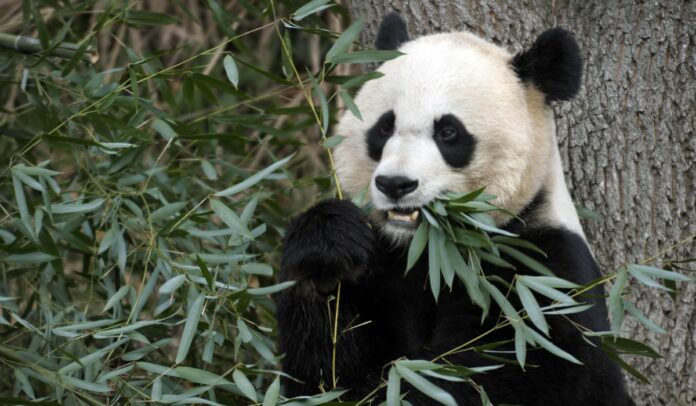Giant panda Mei Xiang gave birth to a cub at Smithsonian’s National Zoo on Friday evening, making her the oldest panda, at 22 years old, in the U.S. and the second oldest in the world to do so.
She is also the first panda in the U.S. to successfully give birth through artificial insemination using only frozen semen.
The panda cub was born at 6:35 p.m., according to the zoo, and Mei Xiang immediately picked up and cradled the cub after its birth.
The panda team is monitoring Mei Xiang and her cub on the zoo’s panda cams. Zoo keepers will perform a neonatal exam when they are able to retrieve the cub, which could take a few days. The sex of the cub will be determined at a later date.
“Giant pandas are an international symbol of endangered wildlife and hope, and with the birth of this precious cub we are thrilled to offer the world a much-needed moment of pure joy,” said Steve Monfort, John and Adrienne Mars Director of the Smithsonian’s National Zoo and Conservation Biology Institute. “Because Mei Xiang is of advanced maternal age, we knew the chances of her having a cub were slim. However, we wanted to give her one more opportunity to contribute to her species’ survival. I am incredibly proud of our animal care and science teams, whose expertise in giant panda behavior was critical to this conservation success.”
Veterinarians at Smithsonian’s National Zoo detected fetal tissue during giant panda Mei Xiang’s (pronounced may-SHONG) ultrasound the first week of August. They had since observed developing skeletal structure and strong blood flow within the giant panda’s uterus. The zoo announced the news of Mei Xiang’s pregnancy on Aug. 14 after her second ultrasound again detected fetal tissue.
Reproductive scientists from the Smithsonian Conservation Biology Institute and zoo veterinarians artificially inseminated Mei Xiang on March 22 with frozen semen collected from 23-year-old Tian Tian (pronounced tee-YEN teen-YEN).
Female giant pandas have a very narrow window for when they can get pregnant, only 24 to 72 hours each year. The panda zoo keepers and a behavioral scientist closely watched Mei Xiang’s behaviors and monitored her hormones to determine the best time to artificially inseminate her.
Behaviors such as an increase in bleats and chirps and walking backward with her tail up could indicate peak estrogen and progesterone rise.
Scientists discovered a secondary rise in Mei Xiang’s urinary progesterone levels on June 10. In late July, the giant panda began sleeping more, eating less, nest building and body licking — behaviors consistent with pregnancy or pseudopregnancy, the zoo said.
The panda house at the national zoo is currently closed to the public to provide peace and quiet for Mei Xiang. The zoo began 24-hour-a-day behavior watch on the panda cams on Aug. 14.
Giant pandas undergo a phenomenon called delayed implantation, which is when an embryo will not attach to the uterine wall until weeks or months after fertilization. The embryo then “grows exponentially” after implantation, the zoo said.
Mei Xiang previously gave birth to three surviving cubs: Tai Shan (tie-SHON) on July 9, 2005, Bao Bao (BOW BOW) on Aug. 23, 2013 and Bei Bei (BAY BAY) on Aug. 22, 2015. All cubs moved to China after their births as part of a cooperative breeding agreement with a wildlife conservation organization. All the cubs moved to China when they were 4 years old. The agreement with the China Wildlife Conservation Association expires in December.
It is unclear if Mei Xiang’s cub will stay at the zoo or will be sent to China.
“The Smithsonian’s National Zoo and Conservation Biology Institute is currently discussing the terms of the next agreement with our colleagues at the China Wildlife and Conservation Association (CWCA). We do not have any updates to share at this time. Our current agreement stipulates that any cubs born at the Zoo must go to China at age four,” said Jennifer Zoon, the zoo’s communications associate.
She described the birth of Mei Xiang’s cub as a “tremendous conservation victory.”
According to Ms. Zoon, only one other panda in China is documented to have given birth at an older age than Mei Xiang at 23 years old.






